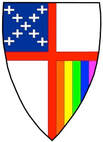|
In this week’s readings we hear the story of Moses’ time on the mountain with God. Did you remember: like Jesus, Moses also spent forty days and forty nights in communion with God. Moses ascended Mt. Sinai, the sacred mountain, symbolically considered the navel of the earth. axis mundi. Here was a space thought to connect this world to the next.
Moses was a mystical character himself. Part of a tradition of rich Jewish mysticism: He sees signs, discerns voices, has visions, you might say, vision quests. He is a man of conviction, a leader - and deeply spiritual. But I would say, (like for most of us) it is with a little hesitance and reluctance at first that Moses responds to all of these calls from God… Moses is pretty human in that regard. He says, “Who me?” But whether or not he deems himself worthy, he does what I’ve spoken about in other sermons… “He feels the fear and does it anyway.” He goes up even though “the appearance of the glory of the Lord was like a devouring fire on the top of the mountain.” But he stays there for forty days and forty nights communing with God. And when he comes down he has been transformed: His face glowed - and he came down from the mountain bringing us the first commandments. In our Gospel story today, what we describe as the Transfiguration, Jesus also goes up a mountain, Mt. Tabor… and “His face shown like the sun.” He takes with him Peter and James and John. Peter recognizes this moment as symbolic of their tradition. He wants to build tents for Jesus, Moses and Elijah to stay there and meditate with God. But … While he was still speaking, suddenly a bright cloud overshadowed them, and from the cloud a voice said, “This is my Son, the Beloved; with him I am well pleased; listen to him!” These are the same words we hear at Jesus’ baptism. As soon as Jesus was baptized, He went up out of the water. Suddenly the heavens were opened,d and He sawe the Spirit of God descending like a dove and resting on Him. 17And a voice from heaven said, “This is My beloved Son, in whom I am well pleased!” Jesus was baptized by the Spirit; The Spirit that we understand as God working in the world. Today we are celebrating the baptism of Liam Michael. And once again the voice resonates: This is my beloved son, in whom I am well pleased! Baptism is about God working in the world. Peter wishes to make a very special and significant offering to the ancestors, but the voice from Heaven we understand to be God’s voice, interrupts and says, “listen to him.” The activity of the Spirit working in the world is present now. Wake up… or “Keep awake!” As Jesus tells us often: God is working in the world. We are at the end of Epiphany, when the Magi came to offer gifts to a tiny child, the one they anticipated would be the messiah. At the time this gospel is written the Matthean community who Matthew is writing to was struggling because Jesus was not the messiah they were anticipating… a strong King to win all of their battles through force. What’s happened? Instead we know that the messiah turns everything on its head: our notion of what is strong. Jesus came to teach us that the nature of God is love and Love is the most powerful force on earth. The Transfiguration points Matthew’s community, and us toward the fuller story of the crucifixion and the resurrection. To remember … The Transfiguration happens only after Jesus started revealing to the disciples that he is going to suffer and that this suffering is part of a larger story about what God is doing in this world. The shape of compassion and forgiveness, the shape of true power, the pattern of God is much richer than worldly power. The pattern of the Spirit working in the world will be one of sacrifice for those we love; of healing and compassion for those we encounter; forgiveness that requires a surrender of our ego. This is Jesus’ way. Early Christians were called followers of the way. A way that engenders a flow of love. Following the way is a wisdom path. It is a path that asks us to keep awake. Christianity is not just a belief system. It is a way of participating in the World. Having Christ as our higher power asks us to operate on two levels which are symbolized in the cross. To keep awake to one another on a horizontal plane while holding a vertical relationship with the holy one. To stand in that space of two worlds. The shape of the cross is transfiguring. It is transformational. The words that Jesus hears: This is my Beloved Son, are important for us, and his friends, but also so important for Jesus’ own strength as he enters into the most scary realization of his human life: that he will suffer. These words, “You are my beloved” are a reminder that God is with him. Jesus goes up the mountain to be reminded that God is the source of life. Like Moses, symbolically communing with God at the navel of the earth (the axis of two worlds) we can be present to both worlds. This is the epiphany of the Transfiguration! Being present and awake on a vertical plane and a horizontal plane are not two different perspectives, but one enlightened way. As the author states in 2nd Peter today: Pay attention to this message: as to a lamp shining in a dark place, until the day dawns and the morning star rises in your hearts. Keep awake. In Baptism we say we are born again, because we recognize we are part of the transfiguration, transformation and the resurrection: part of the body of Christ, meaning we do not live only for ourselves, but we live for the benefit of all human kind, for justice and peace, for the thriving of community that respects the dignity of every human being. We strive to love one another as ourselves. The water of Baptism symbolizes life: water of creation. It is our most ancient of relationships…with the Spirit moving over the waters of creation to bring life to the world. When we speak to dying with Christ in the water of Baptism we are talking about dying to selfishness. Being immersed in the real world, in the chaos of creation; yet rising up through the living water into the knowledge that we are beloved by God and gifted for making a difference in the lives of others in this world. We cannot be a Christian in isolation. It is always a path for the the community’s sake… The water of Baptism symbolizes freedom. In the rite we will pray this, by returning to the story of Moses and our liberation from slavery in Egypt through the parting of the water. Our readings today remind us that Moses and Jesus each spent significant time alone in dialogue with their creator. Their prayer must’ve been full of questions. Their days were dedicated to seeking, discerning and surrender. But this alone-time was not meant to secure private privileged relationship with God. Both Moses and Jesus come down from the mountain with missions, messages and responsibilities for the community. They remind us that God is always working through us for the benefit of others. We say that Holy Baptism is an outward sign of an inward spiritual grace. We make it public because that grace is recognized by and through the community. It is a ritual that says, we believe that Liam is a beloved child of God, with the free will to make choices, but blessed by being part of the body of Christ (us) and with the Holy Spirit (God at work in the world). And all of this together will help him grow into wisdom and Love. In the gift of Baptism we pray to be given an inquiring and discerning heart, the courage and will to persevere. And today we pray that Liam will also be given the gift of joy and wonder in all God’s works. In the renewal of our own baptismal vows, today Remember that each one of you is a beloved child of God. And in you God is well pleased. And with Moses and Jesus… “The LORD bless you and keep you; The LORD make His face shine upon you, And be gracious to you; The LORD lift up His countenance upon you, And give you peace.”
0 Comments
Leave a Reply. |
AuthorThe Rev. Heather K. Sisk Archives
July 2024
Categories |
We Would Love to Have You Visit Soon!
WE ARE ALL MADE IN THE IMAGE OF GOD |
Telephone845-635-2854
|
|
 RSS Feed
RSS Feed

